英语论文格式要求
毕业生英语论文格式要求_论文格式_
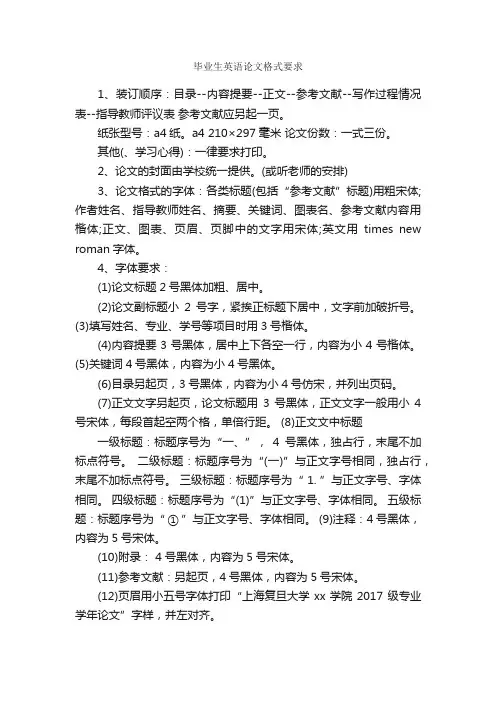
毕业生英语论文格式要求1、装订顺序:目录--内容提要--正文--参考文献--写作过程情况表--指导教师评议表参考文献应另起一页。
纸张型号:a4纸。
a4 210×297毫米论文份数:一式三份。
其他(、学习心得):一律要求打印。
2、论文的封面由学校统一提供。
(或听老师的安排)3、论文格式的字体:各类标题(包括“参考文献”标题)用粗宋体;作者姓名、指导教师姓名、摘要、关键词、图表名、参考文献内容用楷体;正文、图表、页眉、页脚中的文字用宋体;英文用times new roman字体。
4、字体要求:(1)论文标题2号黑体加粗、居中。
(2)论文副标题小2号字,紧挨正标题下居中,文字前加破折号。
(3)填写姓名、专业、学号等项目时用3号楷体。
(4)内容提要3号黑体,居中上下各空一行,内容为小4号楷体。
(5)关键词4号黑体,内容为小4号黑体。
(6)目录另起页,3号黑体,内容为小4号仿宋,并列出页码。
(7)正文文字另起页,论文标题用3号黑体,正文文字一般用小4 号宋体,每段首起空两个格,单倍行距。
(8)正文文中标题一级标题:标题序号为“一、”,4号黑体,独占行,末尾不加标点符号。
二级标题:标题序号为“(一)”与正文字号相同,独占行,末尾不加标点符号。
三级标题:标题序号为“ 1. ”与正文字号、字体相同。
四级标题:标题序号为“(1)”与正文字号、字体相同。
五级标题:标题序号为“ ① ”与正文字号、字体相同。
(9)注释:4号黑体,内容为5号宋体。
(10)附录: 4号黑体,内容为5号宋体。
(11)参考文献:另起页,4号黑体,内容为5号宋体。
(12)页眉用小五号字体打印“上海复旦大学xx学院2017级专业学年论文”字样,并左对齐。
5、纸型及页边距:a4纸(297mm×210mm)。
6、页边距:天头(上)20mm,地角(下)15mm,订口(左)25mm,翻口(右)20mm。
7、装订要求:先将目录、内容摘要、正文、参考文献、写作过程情况表、指导教师评议表等装订好,然后套装在学校统一印制的论文封面之内(用胶水粘贴,订书钉不能露在封面外)。
英文论文格式要求
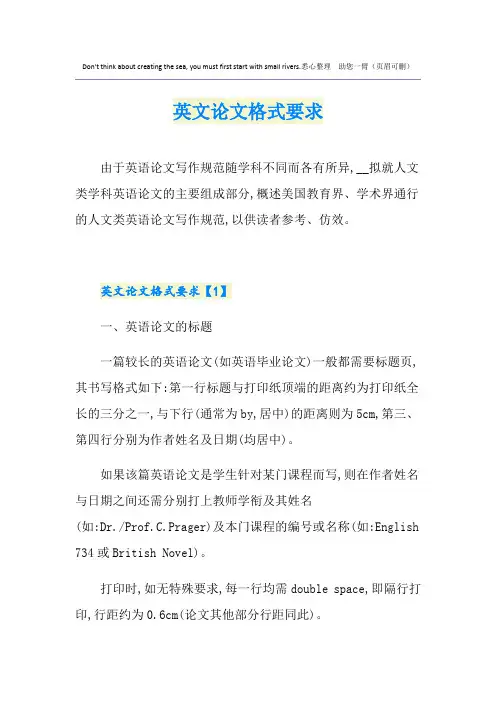
Don't think about creating the sea, you must first start with small rivers.悉心整理助您一臂(页眉可删)英文论文格式要求由于英语论文写作规范随学科不同而各有所异,__拟就人文类学科英语论文的主要组成部分,概述美国教育界、学术界通行的人文类英语论文写作规范,以供读者参考、仿效。
英文论文格式要求【1】一、英语论文的标题一篇较长的英语论文(如英语毕业论文)一般都需要标题页,其书写格式如下:第一行标题与打印纸顶端的距离约为打印纸全长的三分之一,与下行(通常为by,居中)的距离则为5cm,第三、第四行分别为作者姓名及日期(均居中)。
如果该篇英语论文是学生针对某门课程而写,则在作者姓名与日期之间还需分别打上教师学衔及其姓名(如:Dr./Prof.C.Prager)及本门课程的编号或名称(如:English 734或British Novel)。
打印时,如无特殊要求,每一行均需double space,即隔行打印,行距约为0.6cm(论文其他部分行距同此)。
就学生而言,如果英语论文篇幅较短,亦可不做标题页(及提纲页),而将标题页的内容打在正文第一页的左上方。
第一行为作者姓名,与打印纸顶端距离约为2.5cm,以下各行依次为教师学衔和姓、课程编号(或名称)及日期;各行左边上下对齐,并留出2.5cm左右的页边空白(下同)。
接下来便是论文标题及正文(日期与标题之间及标题与正文第一行之间只需隔行打印,不必留出更多空白)。
二、英语论文提纲英语论文提纲页包括论题句及提纲本身,其规范格式如下:先在第一行(与打印纸顶端的距离仍为2.5cm左右)的始端打上Thesis 一词及冒号,空一格后再打论题句,回行时左边须与论题句的第一个字母上下对齐。
主要纲目以大写罗马数字标出,次要纲目则依次用大写英文字母、阿拉伯数字和小写英文字母标出。
各数字或字母后均为一句点,空出一格后再打该项内容的第一个字母;处于同一等级的纲目,其上下行左边必须对齐。
英国毕业论文格式要求
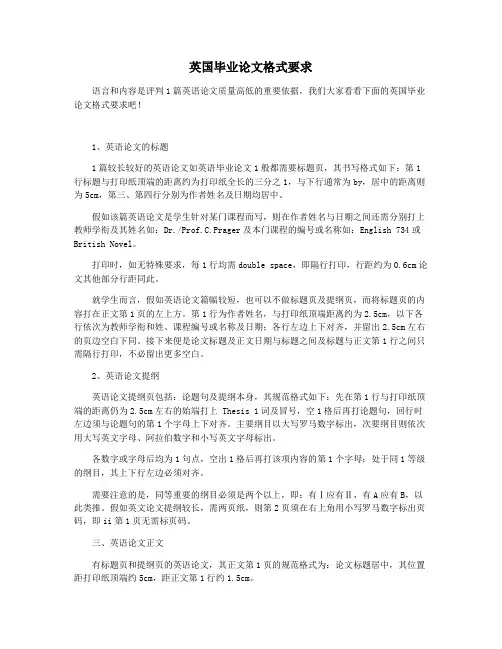
英国毕业论文格式要求语言和内容是评判1篇英语论文质量高低的重要依据,我们大家看看下面的英国毕业论文格式要求吧!1、英语论文的标题1篇较长较好的英语论文如英语毕业论文1般都需要标题页,其书写格式如下:第1行标题与打印纸顶端的距离约为打印纸全长的三分之1,与下行通常为by,居中的距离则为5cm,第三、第四行分别为作者姓名及日期均居中。
假如该篇英语论文是学生针对某门课程而写,则在作者姓名与日期之间还需分别打上教师学衔及其姓名如:Dr./Prof.C.Prager及本门课程的编号或名称如:English 734或British Novel。
打印时,如无特殊要求,每1行均需double space,即隔行打印,行距约为0.6cm论文其他部分行距同此。
就学生而言,假如英语论文篇幅较短,也可以不做标题页及提纲页,而将标题页的内容打在正文第1页的左上方。
第1行为作者姓名,与打印纸顶端距离约为2.5cm,以下各行依次为教师学衔和姓、课程编号或名称及日期;各行左边上下对齐,并留出2.5cm左右的页边空白下同。
接下来便是论文标题及正文日期与标题之间及标题与正文第1行之间只需隔行打印,不必留出更多空白。
2、英语论文提纲英语论文提纲页包括:论题句及提纲本身,其规范格式如下:先在第1行与打印纸顶端的距离仍为2.5cm左右的始端打上 Thesis 1词及冒号,空1格后再打论题句,回行时左边须与论题句的第1个字母上下对齐。
主要纲目以大写罗马数字标出,次要纲目则依次用大写英文字母、阿拉伯数字和小写英文字母标出。
各数字或字母后均为1句点,空出1格后再打该项内容的第1个字母;处于同1等级的纲目,其上下行左边必须对齐。
需要注意的是,同等重要的纲目必须是两个以上,即:有Ⅰ应有Ⅱ,有A应有B,以此类推。
假如英文论文提纲较长,需两页纸,则第2页须在右上角用小写罗马数字标出页码,即ii第1页无需标页码。
三、英语论文正文有标题页和提纲页的英语论文,其正文第1页的规范格式为:论文标题居中,其位置距打印纸顶端约5cm,距正文第1行约1.5cm。
英语论文格式与引用注释规范

英语论文格式与引用注释规范英语论文格式与引用注释规范(试用)一、论文格式(一)论文构成1.封面2.题目、作者等信息页3.致谢(英文,一级标题,字体三号)4.摘要(英文)(一般不超过300-500单词,关键词3—5个)5.摘要(中文)(与英文摘要对应)6.目录(3、4、5、6项以小罗马数字标页码,目录内容字体小四号)7.正文(introduction,body,conclusion)8.参考文献(bibliography)9.附录(有则提供)1.字体:英语用timesnewroman;汉语用宋体.2.字号:标题一律用粗体(boldface);章的标题居中,与正文空两行,每章要开新页;其余标题靠左顶格,上下各空一行间距.一级标题(章标题):三号字体;二级标题:小三号字体;三级标题:四号字体;四级标题:小四号字体.正文字体大小:小四号字体.3.标题序号:文章总标题(小二号字体)chapterone…1.11.1.11.1.1.1…2.12.1.14.引文:少于四行的直接引文置于双引号内;超过四行(包括四行)的引文要与正文隔开,上下各空一行,左边缩进10个字母;如所引原文第一行有缩进,则该行在论文中再缩进三个字母的间距,即引文第一行缩进13个字符;字体小1号使用(即五号字体);行距为1.5.图表:图表应有与内容相符的明确标题;图的标记以第二章图一为例则为:figure2—1,依此类推;表的标记以第二章表一为例则为:table2—1,依此类推.6.行距:除四行及以上引文行距为1外,全文为1.25倍或18磅.二、引文注释规范1.注释或引用分为文内注和文末参考文献两种形式.文内注置于圆括号内,紧跟在引用内容之后;应标出作者姓(名)和页码,之间不用标点,如(bhabha120),若同一作者有多部著作引用,则应在作者姓后分别注出该著作出版年份,如,(weiss1998:76)、(weiss2002:104),等.若在文内已提供被引用者姓名,则只要将引文页码置于圆括号内.若引文文献著者有同姓者,应提供其名的首字母.若著者为多位,可在第一位著者姓之后用“等等”(etal.),也可提供所有著者姓,之间用逗号分隔.若著者为汉语姓氏,提供汉字全名,以免混淆.若引文页码有起止范围,在起止页码之间用单横线连接;若页码有两个及以上,中间用逗号分隔.若引用为间接来源,则应第一引用者姓(名)前注出“转引自”(qtd.in)字样.文内注示例:briantavessuggestssomeinterestingconclusionsregardingthe philosophyandpoliticsoftheadventurefilm(153-54,171).georgemayberry,writinginthenewrepublic,referredto itasa“deeplyandtragicallyhuman”story(108);andedwinj.lukas,inthea nnalsoftheamericanacademyofpoliticalandsocialscience,hailed itasessentialreadingforprofessionalsconcernedwiththecrimina lpersonality(216).theauthorsofwomen’swaysofknowingmakeadistinctionbetween “separateknowing”and“connectedknowing”(belenkyetal.100-30).(多位作者也可以注出所有著者姓,中间用逗号分隔.)。
英语论文格式字号
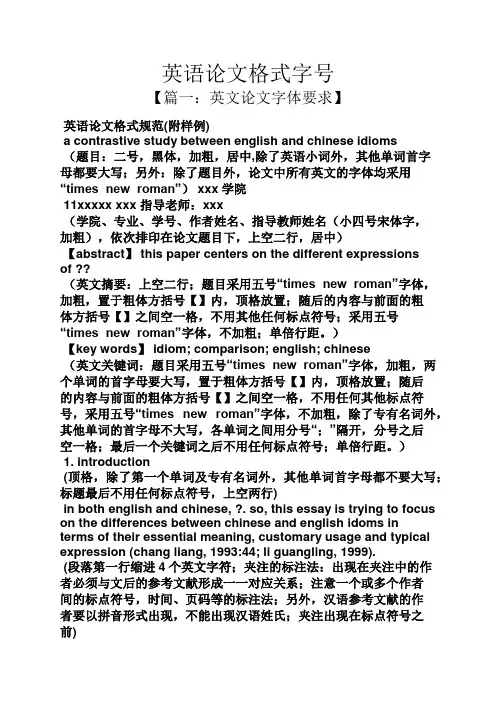
英语论文格式字号【篇一:英文论文字体要求】英语论文格式规范(附样例)a contrastive study between english and chinese idioms(题目:二号,黑体,加粗,居中,除了英语小词外,其他单词首字母都要大写;另外:除了题目外,论文中所有英文的字体均采用“times new roman”) xxx学院11xxxxx xxx 指导老师:xxx(学院、专业、学号、作者姓名、指导教师姓名(小四号宋体字,加粗),依次排印在论文题目下,上空二行,居中)【abstract】 this paper centers on the different expressionsof ??(英文摘要:上空二行;题目采用五号“times new roman”字体,加粗,置于粗体方括号【】内,顶格放置;随后的内容与前面的粗体方括号【】之间空一格,不用其他任何标点符号;采用五号“times new roman”字体,不加粗;单倍行距。
)【key words】 idiom; comparison; english; chinese(英文关键词:题目采用五号“times new roman”字体,加粗,两个单词的首字母要大写,置于粗体方括号【】内,顶格放置;随后的内容与前面的粗体方括号【】之间空一格,不用任何其他标点符号,采用五号“times new roman”字体,不加粗,除了专有名词外,其他单词的首字母不大写,各单词之间用分号“;”隔开,分号之后空一格;最后一个关键词之后不用任何标点符号;单倍行距。
)1. introduction(顶格,除了第一个单词及专有名词外,其他单词首字母都不要大写;标题最后不用任何标点符号,上空两行)in both english and chinese, ?. so, this essay is trying to focus on the differences between chinese and english idoms interms of their essential meaning, customary usage and typical expression (chang liang, 1993:44; li guangling, 1999).(段落第一行缩进4个英文字符;夹注的标注法:出现在夹注中的作者必须与文后的参考文献形成一一对应关系;注意一个或多个作者间的标点符号,时间、页码等的标注法;另外,汉语参考文献的作者要以拼音形式出现,不能出现汉语姓氏;夹注出现在标点符号之前)2. the similarities between english idioms and chinese idiomsin english, ?. and it can be clearly seen in the below examples:(1) i don’t know。
英语专业毕业论文格式
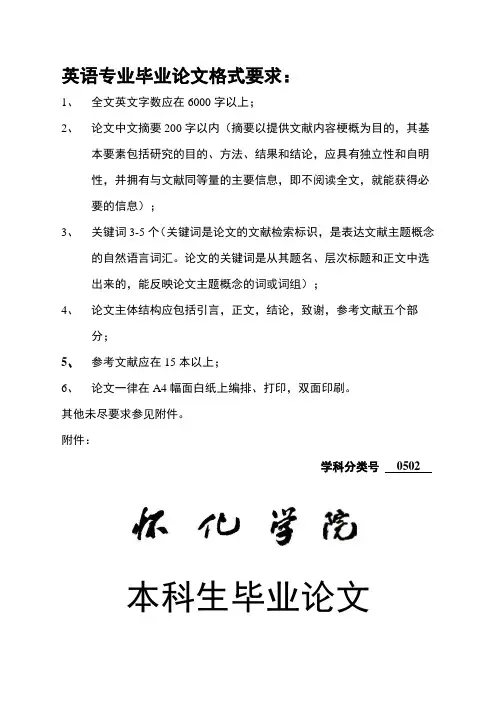
英语专业毕业论文格式要求:1、全文英文字数应在6000字以上;2、论文中文摘要200字以内(摘要以提供文献内容梗概为目的,其基本要素包括研究的目的、方法、结果和结论,应具有独立性和自明性,并拥有与文献同等量的主要信息,即不阅读全文,就能获得必要的信息);3、关键词3-5个(关键词是论文的文献检索标识,是表达文献主题概念的自然语言词汇。
论文的关键词是从其题名、层次标题和正文中选出来的,能反映论文主题概念的词或词组);4、论文主体结构应包括引言,正文,结论,致谢,参考文献五个部分;5、参考文献应在15本以上;6、论文一律在A4幅面白纸上编排、打印,双面印刷。
其他未尽要求参见附件。
附件:学科分类号0502本科生毕业论文题目(中文):学生姓名:学号:系别:专业:英语指导教师:起止日期:2013.6 —2014.52014年5月15日怀化学院本科毕业论文诚信声明作者郑重声明:所呈交的本科毕业论文,是在指导老师的指导下,独立进行研究所取得的成果,成果不存在知识产权争议。
除文中已经注明引用的内容外,论文不含任何其他个人或集体已经发表或撰写过的成果。
对论文的研究做出重要贡献的个人和集体均已在文中以明确的方式标明。
本声明的法律结果由作者承担。
本科毕业论文作者签名:年月日人文社科类目录示例(空一行)Contents(小3号粗体,居中)(小4号空一行)Abstract(小四号Times New Roman) (i)Key words (i)摘要关键词Introduction (1)Chapter One □□Brief Review of FunctionalEquivalence (2)1.1□1.2□1.3□...7 Chapter Two □□A Brief Review of Advertisement Translation from English to Chinese (6)2.1□T argets and Principles of Advertisement T ranslation (7)2.2□Requirements for Advertisement T ranslation................................. (9)2.3□C ultural Elements in AdvertisementT ranslation (11)Chapter Three □□Advertisement Translation from English to Chinese in Light ofFunctionalEquivalence (13)3.1□The Differences Between Two Languages (15)3.2□Functional Equivalence in English Advertisement T ranslation (17)Conclusion (19)Bibliography (20)Acknowledgments ………………………………………………………………….…........26 论文摘要与关键词示例(中、英文)(空一行)A Research of the Evaluation and Prediction of Water Quality of theYangtze River and Measure of Preventing Pollutions(3号Times New Roman居中)(空一行)Abstract(小四号粗体Times New Roman居中)□□This paper studies the water quality status of drainage basin of Yangtze River and its main polluted drainage area in the recent two years by illegibility appraisal model, furthermore, confirms the polluted area of each polluted index by index adjust model in the recent one year.……(小4号Times New Roman)(空一行)Key words(小四号粗体Times New Roman居中)□□Water quality; pollution; illegibility identify appraisal model; index adjust model; linear regress model(小4号Times New Roman)长江流域水质评价、预测与对策研究(3号黑体居中)(空一行)摘□要(小4号黑体居中)□□根据长江沿线17个观测站2003-2005年重要水质指标的检测数据和“1995-2004年长江流域水质报告”给出的主要统计数据,根据模糊识别综合评价模型,对长江水质情况进行了综合评价,分析了长江流域各地区水质污染情况;运用线性回规模型对长江未来十年水质污染的发展趋势进行了预测分析,提出了治理长江水质污染问题的建议和意见。
英文论文的详细格式(英文论文写作格式)
英文论文的详细格式(英文论文写作格式)英文论文的写作主要用于参加国际学术研讨会,以促进中外学术和文化交流;在国际学术期刊上发表论文,在国际上分享科研成果,并在英语论文中进行学术交流;此外,英文论文还包括英语相关专业人士必须用英语撰写学术报告或毕业论文等。
标题大纲摘要1、英文摘要是一篇文章,旨在以符合英语语法的语言提供论文内容的摘要。
(内容与中文摘要基本相同,但不需要完全判断。
)2、英文标题、摘要、关键字进入一个页面(可以是1页),放在中文摘要页面之后。
3、英文字体和行间距:在“Western字体”中使用“Times New Roman”,1.5行间距。
4、英文名称:使用第三个单词bold。
5、英文摘要:“Absract”顶部网格,使用第四个字母和粗体。
英文摘要使用第四个字母。
6、英文关键词:“关键词”顶部网格,使用第四个单词和粗体。
对每个关键字使用第四个单词文本在文中引用如果引用少于三行,则引文可以有机地整合到纸张中。
如果要引用的单词具有与需要删除的纸张无关的单词,则需要省略号。
如果省略号出现在引文中,请使用三个点。
如果它出现在引文的末尾,请使用四个点。
最后一个点表示句点并放在第二个括号之后(通常,避免在引用开始时使用省略号);点和字母之间或点和点之间的空格。
参考书目每个项目的第一行需要打印在顶部网格中,并且所有行都需要缩进五次以区分该项目与其他项目。
英文摘要英文论文摘要,也称为摘要,是论文的重要组成部分。
它旨在提供文献内容的摘要,没有评论和补充说明。
一篇简短的文章,准确描述了文献的重要内容。
摘要应该是独立和不言而喻的,并且与文献具有相同数量的信息,即,可以在不阅读全文的情况下获得重要信息。
摘要通常放在标题之后,即文章的第一篇。
在论文发表后,论文的摘要经常被文献检索系统收集。
英文摘要一般为200-300个单词,并且有一个与英文抽象表达相对应的中文摘要。
,。
英语论文写作格式
英语论文写作格式1. 文章标题英文标题一般在10个实词以内,最多不超过15个实词,避免使用非公知公用的缩略词,代号等.3. 论文如有涉密问题或已在公开期刊上发表,请在篇首页地脚处注明.4. 摘要英文摘要一般为150-180个实词,中文摘要一般在300字以内,中英文摘要应基本一致.其内容应包括研究目的,方法,结果,结论等,禁用”本文”,”作者”,”This paper”等作主语.详见”科技期刊文章摘要的写作要求”.5. 关键词每篇文章可选3~8个能反映文章主要内容的单词,词组或术语.英文关键词应与中文关键词相对应.6.中图分类号请查《中国图书馆分类法》.7. 正文正文篇幅一般希望控制在成书5页(记空格,图表占位)以内.内容力求有创新,论证严谨,语句通顺,文字精炼.8.文中正体,斜体,黑体字符的用法:⑴斜体.变量名称用斜体单字母表示;下标若是由变量转化来的则用斜体;坐标轴(如x,y)和变量(如i,j)用斜体.⑵正体.下标由文字转化来的说明性字符用正体;单位,词头用正体,如nm,pF等;几个特殊常量用正体,如e,i,π等.⑶黑体.矩阵,矢量名称用黑体表示.9.图形要求图中所有线条,文字必须用黑色绘制;用线形或标识符区分;不得有背景;图中线条须清晰,均匀,刻度线向内侧画,并且间隔应均匀;图中坐标线粗0.5磅,曲线宽度为坐标线宽度的3倍;10.表格要求表格采用三线表,表头中使用物理量符号/单位,如下例:x/cmI/mAv/(m·s-1)h/mp/MPa10302.5411011.参考文献来稿引用他人观点与材料,须将参考文献按正文中出现的先后次序列于文后,文中须在引用处右上角加注”「序号」”.中文参考文献必须列出相应的英文,并在后面加注”(in Chinese)”.引文作者姓名均为姓前名后,最多标3名,余下用”et al.”代表.著录格式为:(按不同析出物分类说明)「连续出版物」主要作者.题名「J」 .刊名,年,卷(期):起止页码.「专著」主要作者.书名「M」 .出版地(城市名):出版者,出版年.起止页码.「译著」主要作者.书名「M」 .译者.出版地(城市名):出版者,出版年.起止页码.「论文集」主要作者.题名「A」 .编者.论文集名「C」 .出版地(城市名):出版者,出版年.起止页码.「会议论文」主要作者.题名「Z」 .会议名称,会议召开地(城市名),召开年.「学位论文」作者.题名「D」 .所在城市:保存单位,年份.「研究报告」主要作者.题名「R」 .报告代码及编号(或:保存地点:责任单位),年份.「报纸」作者名.文章名「N」.报纸名,出版日期(版次).「电子文献」作者.题名「EB/OL」.http://………,发表或更新日期/引用日期.「专利」申请者.专利名「P」 .专利国名:专利号,发布日期.「技术标准」技术标准代号,技术标准名称「S」 .。
英语毕业论文格式要求及写作方法
英语毕业论文格式要求及写作方法论文阅读:论文格式论文提纲论文摘要论文致谢论文答辩毕业论文下文《英语毕业论文格式要求及写作方法》是由为大家整理提供,需要毕业论文格式相关内容敬请关注实用资料毕业论文格式专题。
英语毕业论文格式要求及写作方法英语毕业论文格式和规范要求一、英语论文的标题一篇较长的英语论文(如英语毕业论文)一般都需要标题页,其书写格式如下:第一行标题与打印纸顶端的距离约为打印纸全长的三分之一,与下行(通常为by,居中)的距离则为5cm,第三、第四行分别为作者姓名及日期(均居中)。
如果该篇英语论文是学生针对某门课程而写,则在作者姓名与日期之间还需分别打上教师学衔及其姓名(如:Dr./)及本门课程的编号或名称(如:English 734或British Novel)。
打印时,如无特殊要求,每一行均需double space,即隔行打印,行距约为(论文其他部分行距同此)。
就学生而言,如果英语论文篇幅较短,亦可不做标题页(及提纲页),而将标题页的内容打在正文第一页的左上方。
第一行为作者姓名,与打印纸顶端距离约为,以下各行依次为教师学衔和姓、课程编号(或名称)及日期;各行左边上下对齐,并留出左右的页边空白(下同)。
接下来便是论文标题及正文(日期与标题之间及标题与正文第一行之间只需隔行打印,不必留出更多空白)。
二、英语论文提纲英语论文提纲页包括论题句及提纲本身,其规范格式如下:先在第一行(与打印纸顶端的距离仍为左右)的始端打上Thesis 一词及冒号,空一格后再打论题句,回行时左边须与论题句的第一个字母上下对齐。
主要纲目以大写罗马数字标出,次要纲目则依次用大写英文字母、阿拉伯数字和小写英文字母标出。
各数字或字母后均为一句点,空出一格后再打该项内容的第一个字母;处于同一等级的纲目,其上下行左边必须对齐。
需要注意的是,同等重要的纲目必须是两个以上,即:有Ⅰ应有Ⅱ,有A应有B,以此类推。
如果英文论文提纲较长,需两页纸,则第二页须在右上角用小写罗马数字标出页码,即ii(第一页无需标页码)。
英语论文格式要求
英语论文格式要求英语论文的格式要求通常包括以下几个方面:1.封面:在封面上应包括论文的标题、作者的姓名、指导教师的姓名、所属机构和日期等信息。
2.摘要:摘要应简明扼要地介绍论文的研究目的、方法、主要结果和结论,并尽量使用简洁明了的语言。
4.引言:介绍论文的背景和目的,提出研究问题,并对本研究与已有研究的关系进行阐述。
5.文献综述:对已有文献进行综合评述,提供有关研究领域中的相关理论和研究结果。
6.方法:描述研究设计、数据采集和分析方法,以及实施研究的详细步骤。
7.结果:以文字、表格、图表等形式展示研究的主要结果,并对结果进行分析和讨论。
8.讨论:对研究结果进行解释、分析和讨论,阐明研究的意义、局限性和未来研究方向。
9.结论:总结论文的主要发现和结论,再次强调研究的意义和贡献。
11.附录:如果有需要附加的材料,可以将其放在附录中,例如详细的数据表格、统计分析的结果等。
另外,论文的格式要求还包括以下几个方面:1. 字体和字号:通常要求使用12号标准字体,如Times New Roman或Arial。
2.行距和间距:一般要求使用1.5倍行距,并在段落之间留有适当间距。
3.页面设置:通常要求页面边距设置为2.5厘米,页眉和页脚设置为2厘米。
4.标题和标题样式:标题应采用阿拉伯数字依次编号,标题样式一般要求使用粗体或大写字母。
5.引用格式:论文中的引用应符合特定的引用格式和引文样式,如APA(美国心理学协会)、MLA(现代语言协会)等。
6.图片和表格:如果论文中有插图或表格,应给予适当的标题和编号,并在正文中进行解释和引用。
以上是一般英语论文的格式要求,具体要求可能会根据学校和学者的要求而有所不同。
在撰写论文时,最好参考相关的学术期刊或指南来确定具体的格式要求。
- 1、下载文档前请自行甄别文档内容的完整性,平台不提供额外的编辑、内容补充、找答案等附加服务。
- 2、"仅部分预览"的文档,不可在线预览部分如存在完整性等问题,可反馈申请退款(可完整预览的文档不适用该条件!)。
- 3、如文档侵犯您的权益,请联系客服反馈,我们会尽快为您处理(人工客服工作时间:9:00-18:30)。
Paper Title (use style: paper title)Subtitle as neededAuthors Name/s per 1st Affiliation (Author) line 1 (of Affiliation): dept. name of organization line 2: name of organization, acronyms acceptableline 3: City, Countryline 4: e-mail: name@ Authors Name/s per 2nd Affiliation (Author) line 1 (of Affiliation): dept. name of organization line 2: name of organization, acronyms acceptableline 3: City, Countryline 4: e-mail: name@Abstract—This electronic document is a “live” template. T he various components of your paper [title, text, heads, etc.] are already defined on the style sheet, as illustrated by the portions given in this document. DO NOT USE SPECIAL CHARACTERS, SYMBOLS, OR MATH IN YOUR TITLE OR ABSTRACT. (Abstract)Keywords-component; formatting; style; styling; insert (key words)I.I NTRODUCTION (H EADING 1)All manuscripts must be in English. These guidelines include complete descriptions of the fonts, spacing, and related information for producing your proceedings manuscripts. Please follow them and if you have any questions, direct them to the production editor in charge of your proceedings at Conference Publishing Services (CPS): Phone +1 (714) 821-8380 or Fax +1 (714) 761-1784.This template provides authors with most of the formatting specifications needed for preparing electronic versions of their papers. All standard paper components have been specified for three reasons: (1) ease of use when formatting individual papers, (2) automatic compliance to electronic requirements that facilitate the concurrent or later production of electronic products, and (3) conformity of style throughout a conference proceedings. Margins, column widths, line spacing, and type styles are built-in; examples of the type styles are provided throughout this document and are identified in italic type, within parentheses, following the example. PLEASE DO NOT RE-ADJUST THESE MARGINS. Some components, such as multi-leveled equations, graphics, and tables are not prescribed, although the various table text styles are provided. The formatter will need to create these components, incorporating the applicable criteria that follow.II.T YPE S TYLE AND F ONTSWherever Times is specified, Times Roman or Times New Roman may be used. If neither is available on your word processor, please use the font closest in appearance to Times. Avoid using bit-mapped fonts if possible. True-Type 1 or Open Type fonts are preferred. Please embed symbol fonts, as well, for math, etc.III.E ASE OF U SEA.Selecting a Template (Heading 2)First, confirm that you have the correct template for your paper size. This template has been tailored for output on the US-letter paper size. If you are using A4-sized paper, please close this template and download the file for A4 paper format called ―CPS_A4_format‖.B.Maintaining the Integrity of the SpecificationsThe template is used to format your paper and style the text. All margins, column widths, line spaces, and text fonts are prescribed; please do not alter them. You may note peculiarities. For example, the head margin in this template measures proportionately more than is customary. This measurement and others are deliberate, using specifications that anticipate your paper as one part of the entire proceedings, and not as an independent document. Please do not revise any of the current designations.IV.P REPARE Y OUR P APER B EFORE S TYLING Before you begin to format your paper, first write and save the content as a separate text file. Keep your text and graphic files separate until after the text has been formatted and styled. Do not use hard tabs, and limit use of hard returns to only one return at the end of a paragraph. Do not add any kind of pagination anywhere in the paper. Do not number text heads-the template will do that for you.Finally, complete content and organizational editing before formatting. Please take note of the following items when proofreading spelling and grammar:A.Abbreviations and AcronymsDefine abbreviations and acronyms the first time they are used in the text, even after they have been defined in the abstract. Abbreviations such as IEEE, SI, MKS, CGS, sc, dc, and rms do not have to be defined. Do not use abbreviations in the title or heads unless they are unavoidable.B.UnitsUse either SI (MKS) or CGS as primary units. (SI units are encouraged.) English units may be used assecondary units (in parentheses). An exceptionwould be the use of English units as identifiers intrade, such as ―3.5-inch disk drive‖.∙Avoid combining SI and CGS units, such as current in amperes and magnetic field in oersteds. This oftenleads to confusion because equations do not balancedimensionally. If you must use mixed units, clearlystate the units for each quantity that you use in anequation.∙Do not mix complete spellings and abbreviations of units: ―Wb/m2‖ or ―webers per square meter‖, not―webers/m2‖. Spell out units when they appear intext: ―. . . a few henries‖, not ―. . . a few H‖.∙Use a zero before dec imal points: ―0.25‖, not ―.25‖. C.EquationsThe equations are an exception to the prescribed specifications of this template. You will need to determine whether or not your equation should be typed using either the Times New Roman or the Symbol font (please no other font). To create multileveled equations, it may be necessary to treat the equation as a graphic and insert it into the text after your paper is styled.Number equations consecutively. Equation numbers, within parentheses, are to position flush right, as in (1), using a right tab stop. To make your equations more compact, you may use the solidus ( / ), the exp function, or appropriate exponents. Italicize Roman symbols for quantities and variables, but not Greek symbols. Use a long dash rather than a hyphen for a minus sign. Punctuate equations with commas or periods when they are part of a sentence, as inα + β = χ. (1)Note that the equation is centered using a center tab stop. Be sure that the symbols in your equation have been defined before or immediately following the equation. Use ―(1)‖, not ―Eq. (1)‖ or ―equation (1)‖, except at the beginning of a sentence: ―Equation (1) is . . .‖D.Some Common Mistakes∙The word ―data‖ is plural, not singular.∙The subscript for the permeability of vacuum μ0, and other common scientific constants, is zero withsubscript formatting, not a lowercase letter ―o‖.∙In American English, commas, semi-/colons, periods, question and exclamation marks are located withinquotation marks only when a complete thought orname is cited, such as a title or full quotation. Whenquotation marks are used, instead of a bold or italictypeface, to highlight a word or phrase, punctuationshould appear outside of the quotation marks. Aparenthetical phrase or statement at the end of asentence is punctuated outside of the closingparenthesis (like this). (A parenthetical sentence ispunctuated within the parentheses.)∙ A graph within a graph is an ―inset‖, not an ―insert‖.The word alternatively is preferred to the word―alternately‖ (unless you really mean something thatalternates).∙Do not use the word ―essentially‖ to mean ―approximately‖ or ―effectively‖.∙In your paper title, if the words ―that uses‖ can accurately replace the word ―using‖, capitalize the―u‖; if not, keep using lower-cased.∙Be aware of the different meanings of the homophones ―affect‖ and ―effect‖, ―complement‖and ―compliment‖, ―discreet‖ and ―discrete‖,―principal‖ and ―principle‖.∙Do not confuse ―imply‖ and ―infer‖.∙The prefix ―non‖ is not a word; it should be joined to the word it modifies, usually without a hyphen.∙There is no period after the ―et‖ in the Latin abbreviati on ―et al.‖.∙The abbreviation ―i.e.‖ means ―that is‖, and the abbreviation ―e.g.‖ means ―for example‖.An excellent style manual for science writers is [7].V.U SING THE T EMPLATEAfter the text edit has been completed, the paper is ready for the template. Duplicate the template file by using the Save As command, and use the naming convention prescribed by your conference for the name of your paper. In this newly created file, highlight all of the contents and import your prepared text file. You are now ready to style your paper.A.Authors and AffiliationsThe template is designed so that author affiliations are not repeated each time for multiple authors of the same affiliation. Please keep your affiliations as succinct as possible (for example, do not differentiate among departments of the same organization). This template was designed for two affiliations.1)For author/s of only one affiliation (Heading 3): To change the default, adjust the template as follows.a)Selection (Heading 4): Highlight all author and affiliation lines.b)Change number of columns: Select Format > Columns >Presets > One Column.c)Deletion: Delete the author and affiliation lines for the second affiliation.d)For author/s of more than two affiliations: To change the default, adjust the template as follows.e)Selection: Highlight all author and affiliation lines.f)Change number of columns: Select Format > Columns > Presets > One Column.g)Highlight author and affiliation lines of affiliation 1 and copy this selection.h)Formatting: Insert one hard return immediately after the last character of the last affiliation line. Then paste the copy of affiliation 1. Repeat as necessary for each additional affiliation.i)Reassign number of columns: Place your cursor to the right of the last character of the last affiliation line of an even numbered affiliation (e.g., if there are five affiliations, place your cursor at end of fourth affiliation). Drag the cursor up to highlight all of the above author and affiliation lines. Go to Format > Columns and select ―2 Columns‖. I f you have an odd number of affiliations, the final affiliation will be centered on the page; all previous will be in two columns.B.Identify the HeadingsHeadings, or heads, are organizational devices that guide the reader through your paper. There are two types: component heads and text heads.Component heads identify the different components of your paper and are not topically subordinate to each other. Examples include Acknowledgments and References and, for these, the correct style to use is ―Heading5‖. Use ―figurecaption‖ for your Figure captions, and ―table head‖ for your table title. Run-in heads, such as ―Abstract‖, will require you to apply a style (in this case, italic) in addition to the style provided by the drop down menu to differentiate the head from the text.Text heads organize the topics on a relational, hierarchical basis. For example, the paper title is the primary text head because all subsequent material relates and elaborates on this one topic. If there are two or more sub-topics, the next level head (uppercase Roman numerals) should be used and, conversely, if there are not at least two sub-topics, then no subheads should be introduced. Styles named ―Heading 1‖, ―Heading 2‖, ―Heading 3‖, and ―Heading 4‖ are prescribed.C.Figures and Tables1)Positioning Figures and Tables: Place figures and tables at the top and bottom of columns. Avoid placing them in the middle of columns. Large figures and tables may span across both columns. Figure captions should be below the figures; table heads should appear above the tables. Insert figures and tables after they are cited in the text. Use the abbreviation ―Fig. 1‖, even at the beginning of a sentence.TABLE I. T ABLE T YPE S TYLESa. Sample of a Table footnote. (Table footnote)Figure 1. Example of a ONE-COLUMN figure caption.Please see last page of this document for AN EXAMPLE of a 2-COLUMN Figure.Figure Labels: Use 8 point Times New Roman for Figure labels. Use words rather than symbols or abbreviations when writing Figure axis labels to avoid confusing the reader. As an example, write the quantity ―Magnetization‖, or―Magnetization, M‖, not just ―M‖. If including units in the label, present them within parentheses. Do not label axes only with units. In the example, write ―Magnetization (A/m)‖ or ―Magnetization {A[m(1)]}‖, not just ―A/m‖. Do not label axes with a ratio of quantities and units. For example, write ―Temperature (K)‖, not ―Temperature/K‖. D.FootnotesUse footnotes sparingly (or not at all) and place them at the bottom of the column on the page on which they are referenced. Use Times 8-point type, single-spaced. To help your readers, avoid using footnotes altogether and include necessary peripheral observations in the text (within parentheses, if you prefer, as in this sentence).VI.C OPYRIGHT F ORMS AND R EPRINT O RDERS You must submit the IEEE Electronic Copyright Form (ECF) per Step 7 of the CPS author kit’s web page. THIS FORM MUST BE SUBMITTED IN ORDER TO PUBLISH YOUR PAPER.Please see Step 9 for ordering reprints of your paper. Reprints may be ordered using the form provided as <reprint.doc> or <reprint.pdf>.A CKNOWLEDGMENTThe preferred spelling of the word ―acknowledgment‖ in America is without an ―e‖ after the ―g‖. Avoid the stilted expression, ―One of us (R.B.G.) thanks . . .‖ Instead, try ―R.B.G. thanks‖. Put applicable sponsor acknowledgments here; DO NOT place them on the first page of your paper or as a footnote.R EFERENCESList and number all bibliographical references in 9-point Times, single-spaced, at the end of your paper. When referenced in the text, enclose the citation number in square brackets, for example [1]. Where appropriate, include the name(s) of editors of referenced books. The template will number citations consecutively within brackets [1]. The sentence punctuation follows the bracket [2]. Refer simply to the reference number, as in [3]—do not use ―Ref. [3]‖ or ―reference [3]‖ except at the beginning of a sentence: ―Reference [3] was the first. . .‖Number footnotes separately in superscripts. Place the actual footnote at the bottom of the column in which it was cited. Do not put footnotes in the reference list. Use letters for table footnotes.Unless there are six authors or more give all authors’names; do not use ―et al.‖. Papers that have not been published, even if they have been submitted for publication,should be cited as ―unpublished‖ [4]. Papers that have been accepted for publication should be cited as ―in press‖ [5]. Capitalize only the first word in a paper title, except for proper nouns and element symbols.For papers published in translation journals, please give the English citation first, followed by the original foreign-language citation [6].[1]G. Eason, B. Noble, and I. N. Sned don, ―On certain integrals ofLipschitz-Hankel type involving products of Bessel functions,‖ Phil.Trans. Roy. Soc. London, vol. A247, pp. 529–551, April 1955.(references)[2]J. Clerk Maxwell, A Treatise on Electricity and Magnetism, 3rd ed.,vol. 2. Oxford: Clarendon, 1892, pp.68–73.[3]I. S. Jacobs and C. P. Bean, ―Fine particles, thin films and exchangeanisotropy,‖ in Magnetism, vol. III, G. T. Rado and H. Suhl, Eds.New York: Academic, 1963, pp. 271–350.[4]K. Elissa, ―Title of paper if known,‖ unpublished.[5]R. Nicole, ―Title of paper with only first word capitalized,‖ J. NameStand. Abbrev., in press.[6]Y. Yorozu, M. Hirano, K. Oka, and Y. Tagawa, ―Electronspectroscopy studies on magneto-optical media and plastic substrate interface,‖ IEEE Transl. J. Magn. Japan, vol. 2, pp. 740–741, August 1987 [Digests 9th Annual Conf. Magnetics Japan, p. 301, 1982]. [7]M. Young, The Technical Writer’s Handbook. Mill Valley, CA:University Science, 1989.[8]Electronic Publication: Digital Object Identifiers (DOIs):Article in a journal:[9] D. Kornack and P. Rakic, ―Cell Proliferation without Neurogenesis inAdult Primate Neocortex,‖ Science, vol. 294, Dec. 2001, pp. 2127-2130, doi:10.1126/science.1065467.Article in a conference proceedings:[10]H. Goto, Y. Hasegawa, and M. Tanaka, ―Efficien t SchedulingFocusing on the Duality of MPL Representatives,‖ Proc. IEEE Symp.Computational Intelligence in Scheduling (SCIS 07), IEEE Press, Dec.2007, pp. 57-64, doi:10.1109/SCIS.2007.357670.Figure 2. Example of a TWO-COLUMN figure caption: (a) this is the format for referencing parts of a figure.。
